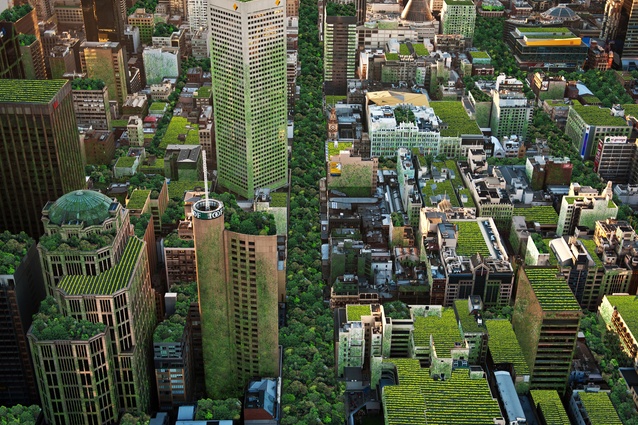It looks like you're using an Ad Blocker.
Please white-list or disable AboveTopSecret.com in your ad-blocking tool.
Thank you.
Some features of ATS will be disabled while you continue to use an ad-blocker.
share:
Suddenly science is starting to realize the importance of tree's.
So how are our tree's doing....
Regardless if we believe that CO2 is increasing from man made pollution or naturally, from a warming earth. Its clear that a warming earth is melting the Alaska's and Siberia's permafrosts which increases atmospheric CO2, promoting greater tree growth.
So increased tree growth from increasing concentrations of CO2 might be considered the earths natural climate thermostat which helps cool the planet. But if tree's are being destroyed faster than they are replenished, the thermostat will fail to modulate the climate. So instead of trying to profit from increasing amounts of atmospheric CO2, we need to preserve our remaining worlds forests, free from human intervention.
A spanner in the works is a theory suggested by Henrik Svensmark Solar-Cosmic Ray Theory . That cosmic rays increase cloud formation when the suns magentic field weakens which typically occurs during periods of low sunspot activity (Maunder Minimum etc which occurred during last little Ice Age). With NASA forcasting that the next solar Cycle could be one of the weakest in centuries. Does that mean we could very be headed into another Little Ice Age if his theory is correct.
A recent study supports Henrik Svensmark theory...
Regardless of an uncertain future in which the only constant we can count on is change. We do know that trees create Oxygen from CO2. And Oxygen is more important to us than profit
Plant a tree or two.
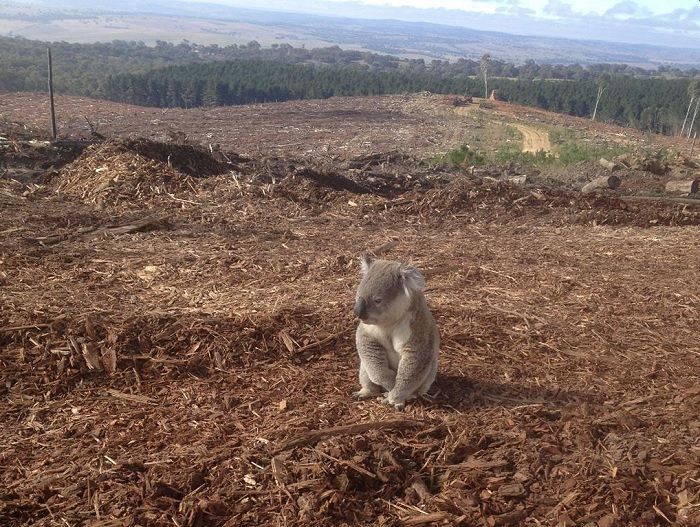
Trees are much better at creating clouds and cooling the climate than we thought....
The pre-industrial atmosphere contained more particles, and so brighter clouds, than we previously thought. This is the latest finding of the CLOUD experiment, a collaboration between around 80 scientists at the CERN particle physics lab near Geneva. It changes our understanding of what was in the atmosphere before humans began adding pollution – and what it might be like again in the future. Most cloud droplets need tiny airborne particles to act as "seeds" for their formation and growth. If a cloud has more of these seeds, and therefore more droplets, it will appear brighter and reflect away more sunlight from the Earth's surface. This in turn can cool the climate. Therefore understanding the number and size of particles in the atmosphere is vital to predicting not only how bright and reflective the planet's clouds are, but what global temperatures will be.
The CLOUD experiment at CERN also recently discovered that gases emitted by trees can stick together to make new seeds for clouds in the atmosphere – without needing any help from other pollutants as was previously thought.
Recent findings from CERN
So how are our tree's doing....
The statistics paint a grim picture. According to the World Resources Institute, more than 80 percent of the Earth’s natural forests already have been destroyed. Up to 90 percent of West Africa’s coastal rain forests have disappeared since 1900. Brazil and Indonesia, which contain the world’s two largest surviving regions of rain forest, are being stripped at an alarming rate by logging, fires, and land-clearing for agriculture and cattle-grazing
National Geographic
Regardless if we believe that CO2 is increasing from man made pollution or naturally, from a warming earth. Its clear that a warming earth is melting the Alaska's and Siberia's permafrosts which increases atmospheric CO2, promoting greater tree growth.
Dr. David Schimel from NASA's Jet Propulsion Laboratory found in a recent study that, contrary to popular ignorance, carbon dioxide isn't necessarily destroying the planet as we've all been told. Any carbon surpluses resulting from natural warming or cooling cycles are actually helping improve biodiversity in many of the world's most remote ecosystems, including in the great rainforests of South America.
In terms of climate change, this means that trees and other plant life thrive from the carbon released into the atmosphere
Link
So increased tree growth from increasing concentrations of CO2 might be considered the earths natural climate thermostat which helps cool the planet. But if tree's are being destroyed faster than they are replenished, the thermostat will fail to modulate the climate. So instead of trying to profit from increasing amounts of atmospheric CO2, we need to preserve our remaining worlds forests, free from human intervention.
A spanner in the works is a theory suggested by Henrik Svensmark Solar-Cosmic Ray Theory . That cosmic rays increase cloud formation when the suns magentic field weakens which typically occurs during periods of low sunspot activity (Maunder Minimum etc which occurred during last little Ice Age). With NASA forcasting that the next solar Cycle could be one of the weakest in centuries. Does that mean we could very be headed into another Little Ice Age if his theory is correct.
A recent study supports Henrik Svensmark theory...
A recent study published in the Aug. 19th issue of Journal of Geophysical Research: Space Physics supports the idea of an important connection between cosmic rays and clouds. According to spaceweather.com, a team of scientists from the Technical University of Denmark (DTU) and the Hebrew Univerwsity of Jerusalem has linked sudden decreases in cosmic rays to changes in Earth's cloud cover. These rapid decreases in the observed galactic cosmic ray intensity are known as “Forbush Decreases” and tend to take place following coronal mass ejections (CMEs) in periods of high solar activity. When the sun is active (i.e., solar storms, CMEs), the magnetic field of the plasma solar wind sweeps some of the galactic cosmic rays away from Earth. In periods of low solar activity, more cosmic rays bombard the earth. The term “Forbush Decrease” was named after the American physicist Scott E. Forbush, who studied cosmic rays in the 1930s and 1940s. The research team led by Jacob Svensmark of DTU identified the strongest 26 “Forbush Decreases” between 1987 and 2007, and looked at ground-based and satellite records of cloud cover to see what happened. In a recent press release, their conclusions were summarized as follows: "[Strong “Forbush Decreases”] cause a reduction in cloud fraction of about 2 percent corresponding to roughly a billion tonnes of liquid water disappearing from the atmosphere."
Link
Regardless of an uncertain future in which the only constant we can count on is change. We do know that trees create Oxygen from CO2. And Oxygen is more important to us than profit
Plant a tree or two.

a reply to: glend
Now this is good stuff!
I have planted over a thousand trees/shrubs
in my lifetime. Not mono culture either.
Enough to cover my carbon footprint,
and yours.
The deforestation that has been occurring
is downright criminal on this planet.
In fact it is self destructive.
S&F
Now this is good stuff!
I have planted over a thousand trees/shrubs
in my lifetime. Not mono culture either.
Enough to cover my carbon footprint,
and yours.
The deforestation that has been occurring
is downright criminal on this planet.
In fact it is self destructive.
S&F
a reply to: Rezlooper
I don't have anything against hemp but feel that a combination of solar, wind and tidal energy can power most of the earths needs for the forseeable future without needing to burn anything for energy. We just need to have more energy efficient homes and appliances to realize the potential of being totally pollution free.
Unfortuantely industry is slow to move. It still operates in a generation when energy was cheap. We still drive around in cars that weigh 10X more than its occupants. We need to introduce new technology into mainstream far quicker as increases in the cost of energy is negative to economies.
I don't have anything against hemp but feel that a combination of solar, wind and tidal energy can power most of the earths needs for the forseeable future without needing to burn anything for energy. We just need to have more energy efficient homes and appliances to realize the potential of being totally pollution free.
Unfortuantely industry is slow to move. It still operates in a generation when energy was cheap. We still drive around in cars that weigh 10X more than its occupants. We need to introduce new technology into mainstream far quicker as increases in the cost of energy is negative to economies.
originally posted by: glend
Suddenly science is starting to realize the importance of tree's.
Trees are much better at creating clouds and cooling the climate than we thought....
The pre-industrial atmosphere contained more particles, and so brighter clouds, than we previously thought. This is the latest finding of the CLOUD experiment, a collaboration between around 80 scientists at the CERN particle physics lab near Geneva. It changes our understanding of what was in the atmosphere before humans began adding pollution – and what it might be like again in the future. Most cloud droplets need tiny airborne particles to act as "seeds" for their formation and growth. If a cloud has more of these seeds, and therefore more droplets, it will appear brighter and reflect away more sunlight from the Earth's surface. This in turn can cool the climate. Therefore understanding the number and size of particles in the atmosphere is vital to predicting not only how bright and reflective the planet's clouds are, but what global temperatures will be.
The CLOUD experiment at CERN also recently discovered that gases emitted by trees can stick together to make new seeds for clouds in the atmosphere – without needing any help from other pollutants as was previously thought.
Recent findings from CERN
So how are our tree's doing....
The statistics paint a grim picture. According to the World Resources Institute, more than 80 percent of the Earth’s natural forests already have been destroyed. Up to 90 percent of West Africa’s coastal rain forests have disappeared since 1900. Brazil and Indonesia, which contain the world’s two largest surviving regions of rain forest, are being stripped at an alarming rate by logging, fires, and land-clearing for agriculture and cattle-grazing
National Geographic
Regardless if we believe that CO2 is increasing from man made pollution or naturally, from a warming earth. Its clear that a warming earth is melting the Alaska's and Siberia's permafrosts which increases atmospheric CO2, promoting greater tree growth.
Dr. David Schimel from NASA's Jet Propulsion Laboratory found in a recent study that, contrary to popular ignorance, carbon dioxide isn't necessarily destroying the planet as we've all been told. Any carbon surpluses resulting from natural warming or cooling cycles are actually helping improve biodiversity in many of the world's most remote ecosystems, including in the great rainforests of South America.
In terms of climate change, this means that trees and other plant life thrive from the carbon released into the atmosphere
Link
So increased tree growth from increasing concentrations of CO2 might be considered the earths natural climate thermostat which helps cool the planet. But if tree's are being destroyed faster than they are replenished, the thermostat will fail to modulate the climate. So instead of trying to profit from increasing amounts of atmospheric CO2, we need to preserve our remaining worlds forests, free from human intervention.
A spanner in the works is a theory suggested by Henrik Svensmark Solar-Cosmic Ray Theory . That cosmic rays increase cloud formation when the suns magentic field weakens which typically occurs during periods of low sunspot activity (Maunder Minimum etc which occurred during last little Ice Age). With NASA forcasting that the next solar Cycle could be one of the weakest in centuries. Does that mean we could very be headed into another Little Ice Age if his theory is correct.
A recent study supports Henrik Svensmark theory...
A recent study published in the Aug. 19th issue of Journal of Geophysical Research: Space Physics supports the idea of an important connection between cosmic rays and clouds. According to spaceweather.com, a team of scientists from the Technical University of Denmark (DTU) and the Hebrew Univerwsity of Jerusalem has linked sudden decreases in cosmic rays to changes in Earth's cloud cover. These rapid decreases in the observed galactic cosmic ray intensity are known as “Forbush Decreases” and tend to take place following coronal mass ejections (CMEs) in periods of high solar activity. When the sun is active (i.e., solar storms, CMEs), the magnetic field of the plasma solar wind sweeps some of the galactic cosmic rays away from Earth. In periods of low solar activity, more cosmic rays bombard the earth. The term “Forbush Decrease” was named after the American physicist Scott E. Forbush, who studied cosmic rays in the 1930s and 1940s. The research team led by Jacob Svensmark of DTU identified the strongest 26 “Forbush Decreases” between 1987 and 2007, and looked at ground-based and satellite records of cloud cover to see what happened. In a recent press release, their conclusions were summarized as follows: "[Strong “Forbush Decreases”] cause a reduction in cloud fraction of about 2 percent corresponding to roughly a billion tonnes of liquid water disappearing from the atmosphere."
Link
Regardless of an uncertain future in which the only constant we can count on is change. We do know that trees create Oxygen from CO2. And Oxygen is more important to us than profit
Plant a tree or two.
While I agree about planting trees, I must correct some things.
1) Our CO2 emissions exceed the rise in atmospheric CO2, so it's pretty clear we're doing it.
2) Oxygen does not come from CO2, but from the H2O in photosynthesis; additionally, plants become more efficient with H2O as CO2 rises - combined, along with our burning Carbon (creating CO2 from Carbon + atmospheric Oxygen), is causing this:
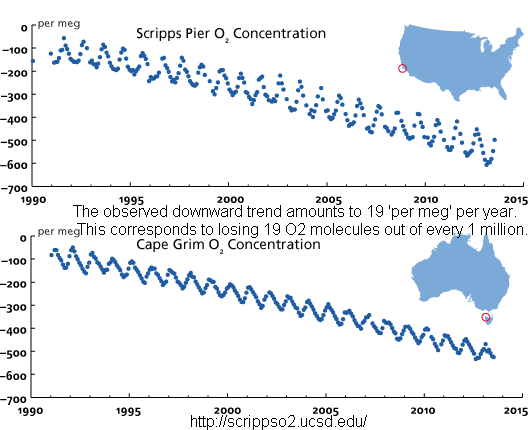
Have you noticed lately you can never find a shady spot to park your car in?
Trees make shadows. Shadows make Summer temps bearable.
Trees make shadows. Shadows make Summer temps bearable.
originally posted by: dfnj2015
a reply to: glend
We should take all the money we spend on defense and put it into planting trees!
Do you realize the ramifications of that many trees?
If we had it your way, we'd be over run by Bigfoots and bears and other furry things in no time.
With no money to fight them.
Because we spent all of our money on trees.
edit on 2017-06-09T21:15:45-05:002201709America/Chicago6 by c2oden because: (no reason given)
originally posted by: Snarl
Have you noticed lately you can never find a shady spot to park your car in?
Trees make shadows. Shadows make Summer temps bearable.
You got a # park then. Cities with no trees in their park are idiotic. It isn't even a park. More like a parking lot.
a reply to: Greven
Thanks Greven for the corrections.
32 million acres of tropical rainforest have been cut down, every year, since 2000 which IPCC tells us adds 10 to 15% to human attributed C02 output. But what isn't known was the ability of past forests to moderate and clense CO2 from the atmosphere. Vostok tells us that CO2 levels were cyclic between 200-300ppm. If the worlds forests still existed. Would CO2 levels have risen above 300ppm today. We simply don't know!
So human CO2 output may not be the problem. The CO2 levels might be rising unnaturally because we are destroying our habitat, crippling its ability to clense the atmosphere of CO2. So it accumulates.
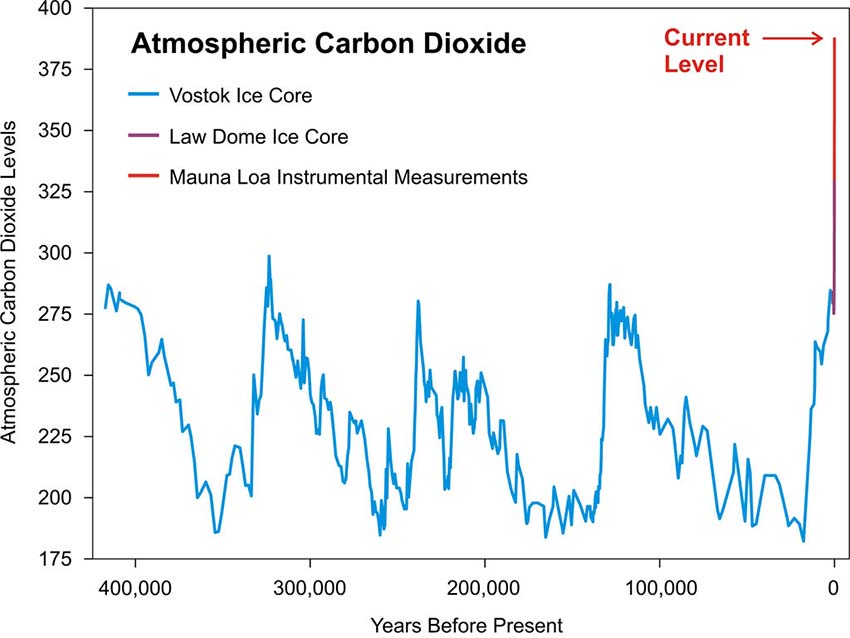
Thanks Greven for the corrections.
Our CO2 emissions exceed the rise in atmospheric CO2, so it's pretty clear we're doing it.
32 million acres of tropical rainforest have been cut down, every year, since 2000 which IPCC tells us adds 10 to 15% to human attributed C02 output. But what isn't known was the ability of past forests to moderate and clense CO2 from the atmosphere. Vostok tells us that CO2 levels were cyclic between 200-300ppm. If the worlds forests still existed. Would CO2 levels have risen above 300ppm today. We simply don't know!
So human CO2 output may not be the problem. The CO2 levels might be rising unnaturally because we are destroying our habitat, crippling its ability to clense the atmosphere of CO2. So it accumulates.

edit on 9-6-2017 by glend because: (no reason given)
a reply to: Greven
While you are correct about the 02 coming from the H20, you have confused transpiration with respiration.
At increased levels of CO2 the leaf stomata of plants close smaller which also reduces the amount of water lost by the plant via transpiration. Increased C02 levels result in increased photosynthesis resulting in more C02 used up and more 02 given off during respiration.
We are in an era now of Global Greening, crop yields are up and the earths biomass has markedly increased. At levels around 150 plants DIE. 400 ppm is not dangerous, it's beneficial.
2) Oxygen does not come from CO2, but from the H2O in photosynthesis; additionally, plants become more efficient with H2O as CO2 rises - combined, along with our burning Carbon (creating CO2 from Carbon + atmospheric Oxygen), is causing this:
While you are correct about the 02 coming from the H20, you have confused transpiration with respiration.
At increased levels of CO2 the leaf stomata of plants close smaller which also reduces the amount of water lost by the plant via transpiration. Increased C02 levels result in increased photosynthesis resulting in more C02 used up and more 02 given off during respiration.
We are in an era now of Global Greening, crop yields are up and the earths biomass has markedly increased. At levels around 150 plants DIE. 400 ppm is not dangerous, it's beneficial.
edit on 9-6-2017 by D8Tee because: (no reason given)
edit on 9-6-2017 by D8Tee because: (no
reason given)
originally posted by: D8Tee
a reply to: Greven
2) Oxygen does not come from CO2, but from the H2O in photosynthesis; additionally, plants become more efficient with H2O as CO2 rises - combined, along with our burning Carbon (creating CO2 from Carbon + atmospheric Oxygen), is causing this:
While you are correct about the 02 coming from the H20, you have confused transpiration with respiration.
At increased levels of CO2 the leaf stomata of plants close smaller which also reduces the amount of water lost by the plant via transpiration. Increased C02 levels result in increased photosynthesis resulting in more C02 used up and more 02 given off during respiration.
We are in an era now of Global Greening, crop yields are up and the earths biomass has markedly increased. At levels around 150 plants DIE. 400 ppm is not dangerous, it's beneficial.
Oxygen moves through the same pathways as water vapor and CO2. Fewer/closed stomata resulting from increased CO2 levels means less O2 emission. Don't forget that plants also consume O2 when they respire, the rate of which appears to increase with enhanced CO2 levels.
Transpiration is when a plant emits oxygen and water vapor. Respiration is very similar to animals, and happens at a cellular level - input O2 output CO2.
edit on 2Sat, 10 Jun 2017 02:00:26 -0500America/ChicagovAmerica/Chicago6 by Greven because: (no reason given)
a reply to: Greven
Of course a plant that is gaining mass faster at increased C02 levels is taking in additional C02 and putting out more 02. All of the carbon that makes up a plants tissues is fixed from the C02 in the air, you know that. Plants at a higher C02 level are more efficient with water, the stomata present less open surface are for water to evaporate out of, just another bonus for us to enjoy at the levels we're at today. Crop yields up all over this world, it is a Global Greening taking place. Plant growth is going into overdrive.
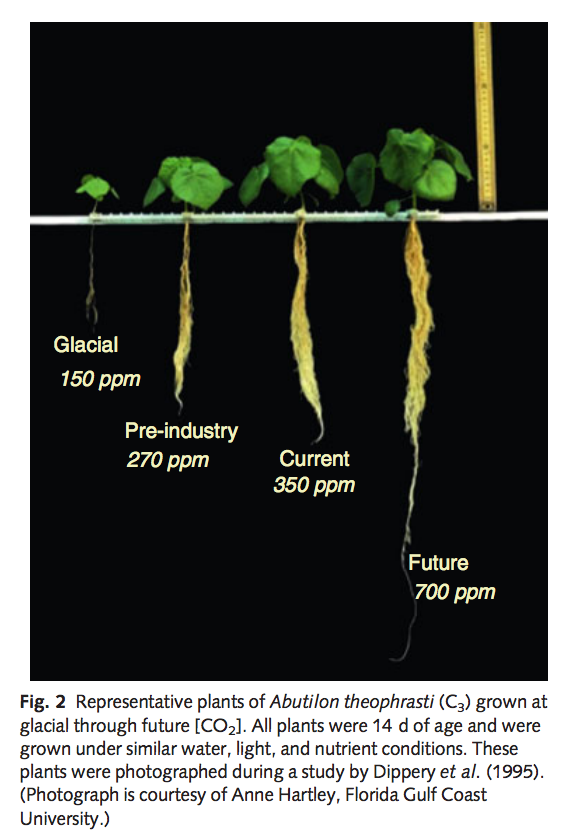
Of course a plant that is gaining mass faster at increased C02 levels is taking in additional C02 and putting out more 02. All of the carbon that makes up a plants tissues is fixed from the C02 in the air, you know that. Plants at a higher C02 level are more efficient with water, the stomata present less open surface are for water to evaporate out of, just another bonus for us to enjoy at the levels we're at today. Crop yields up all over this world, it is a Global Greening taking place. Plant growth is going into overdrive.

edit on 10-6-2017 by D8Tee because: (no reason given)
extra DIV new topics
-
Swarms of tiny 'ant-like' robots lift heavy objects and navigate obstacles
Science & Technology: 57 minutes ago -
NYPD Chief Jeffrey Maddrey Resigns - Forced Officers to Give Sex for Overtime Pay and Favors.
Posse Comitatus: 2 hours ago -
The Carpet Coating that Attacked the Environment
Medical Issues & Conspiracies: 6 hours ago -
Microplastics in your drinks
Medical Issues & Conspiracies: 7 hours ago
top topics
-
The Carpet Coating that Attacked the Environment
Medical Issues & Conspiracies: 6 hours ago, 11 flags -
China Working on 'Drone Mothership' Plane
Military Projects: 12 hours ago, 10 flags -
Microplastics in your drinks
Medical Issues & Conspiracies: 7 hours ago, 5 flags -
Happy Rush Day 2024 - 2112
Music: 12 hours ago, 4 flags -
12-21-24 Usyk-Fury II
World Sports: 15 hours ago, 1 flags -
NYPD Chief Jeffrey Maddrey Resigns - Forced Officers to Give Sex for Overtime Pay and Favors.
Posse Comitatus: 2 hours ago, 1 flags -
Swarms of tiny 'ant-like' robots lift heavy objects and navigate obstacles
Science & Technology: 57 minutes ago, 1 flags
active topics
-
Swarms of tiny 'ant-like' robots lift heavy objects and navigate obstacles
Science & Technology • 1 • : imitator -
An Interesting Conversation with ChatGPT
Science & Technology • 32 • : Sasquatch1111 -
Drones everywhere in New Jersey ---and Elsewhere Master Thread
Aliens and UFOs • 221 • : imitator -
Donald Trump Should Offer AMNESTY to the BIDEN FAMILY For Indicting Blackmailers-Controllers.
US Political Madness • 78 • : WeMustCare -
JOSEPH BIDEN Says Democrat Coup Leaders Forced Him to Resign the Presidency - Eff 1.20.2025.
2024 Elections • 55 • : WeMustCare -
Democrat Leader Hakeem Jeffries Promotes HATE After 2nd Attempt to Murder Trump in 2024.
US Political Madness • 41 • : WeMustCare -
Flying saucer spotted during the Trump assassination attempt
Aliens and UFOs • 66 • : WeMustCare -
Microplastics in your drinks
Medical Issues & Conspiracies • 13 • : WeMustCare -
NYPD Chief Jeffrey Maddrey Resigns - Forced Officers to Give Sex for Overtime Pay and Favors.
Posse Comitatus • 4 • : WeMustCare -
'Mass Casualty event' - Attack at Christmas market in Germany
Mainstream News • 136 • : 777Vader

